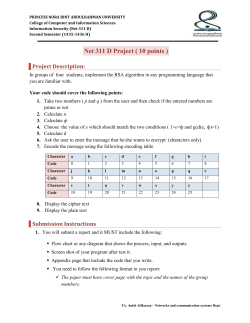
Ch 20 Electric Current, Resistance and Ohm`s Law
Ch 20 Electric Current, Resistance and Ohm’s Law 20.1. Current • Define electric current, ampere, and drift velocity • Describe the direction of charge flow in conventional current. • Use drift velocity to calculate current and vice versa. Electric current. Drift velocity. Conduction of electricity and heat. Example 20.1 Calculating currents: Current in a truck battery and a handheld calculator. Example 20.2 Calculating the number of electrons that move through a calculator. Example 20.3 Calculating drift velocity in a common wire. Definition of electric current, : Units: [ ] Although in most circuits the moving charges are negatively-charged electrons, the direction of the current is defined as the one in which a positive charge would move. 20.2. Ohm’s Law: Resistance and Simple Circuits • Explain the origin of Ohm’s law. • Calculate voltages, currents, or resistances with Ohm’s law. • Explain what an ohmic material is. • Describe a simple circuit. Ohm’s Law. Resistance and simple circuits. Example 20.4 Calculating resistance: an automobile headlight. When voltage is placed across an object to make current flow, the object’s resistance is defined by Units: [ ] Ohm’s Law: and ⁄ is a constant. 20.3. Resistance and Resistivity • Explain the concept of resistivity. • Use resistivity to calculate the resistance of specified configurations of material. • Use the thermal coefficient of resistivity to calculate the change of resistance with temperature. Material and shape dependence of resistance. Temperature variation of resistance. Table 20.1 Resistivities of various materials at 20°C. Example 20.5 Calculating resistor diameter: a headlight filament. Table 20.2 Temperature coefficients of resistivity . Example 20.6 Calculating resistance: hot-filament resistance. Resistivity. This is a property of the material an object is made of. If the object has length the resistivity is defined by ⁄ Units: [ ] Variation with temperature: the temperature, is the reference temperature (often room temperature resistivity of the material. Units: If [ ] , then [ ] . ), and and cross-sectional area , then , where is is the temperature coefficient of 20.4. Electric Power and Energy • Calculate the power dissipated by a resistor and power supplied by a power supply. • Calculate the cost of electricity under various circumstances. Power in electric circuits. The cost of electricity. Example 20.7 Calculating power dissipation and current: hot and cold power. Example 20.8 Calculating the cost effectiveness of compact fluorescent lights (CFL) The electrical power provided by a source of EMF, or heat dissipating power of a resistor is Energy Usage. To compare SI units with utility bills, note that . -------------------------------------------------------------------------------------------------------------------------------------------------------20.5 Alternating Current versus Direct Current 20.6 Electric hazards and the Human Body 20.7 Nerve Conduction – Electrocardiograms Glossary / Section Summary / Conceptual Questions / Problems and Exercises
© Copyright 2025









